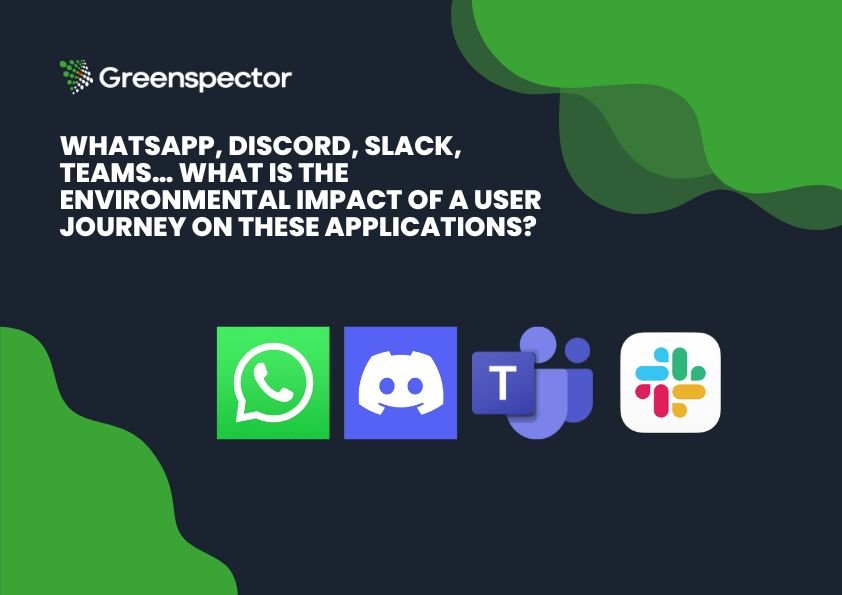Introduction
The advent of instant messaging has transformed communications in the business world. In a world where speed is crucial, these applications offer a platform for real-time exchange, coordination and decision-making. Applications such as Microsoft Teams, Slack, WhatsApp and Discord and many others have thus changed the way teams interact, removing geographical limitations and facilitating communication. Instant messaging has also played a crucial role in the evolution of remote working, providing continuous connectivity between collaborators. However, behind this ease of use and speed lies an aspect that is often overlooked: the environmental impact of these applications.

Discord

Slack


Teams
The impact of these applications is all the greater because they are widely used in companies, but also because they are consumed over long and frequent periods. That’s why it’s interesting to know the unitary impact of these uses, and to be able to project more global impacts.
Methodology
User path definition
For the measurement, we have determined a scenario that is compatible with all applications:
- Step 0: 30s reference pause (with no application open)
- Step 1: open application
- Step 2: 30s pause with application open
- Step 3: send message
- Step 4: pause for 30s to read message
- Step 5: receive reply
- Step 6: send reply
- Step 7: pause conversation for 30s while the other writes the message
- Step 8: send an image (60.54 Kb)
- Step 9: pause for 30s to view the image
- Step 10: receive image (6.50 kB)
- Step 11: send .gif file (3.36 MB)
- Step 12: pause for 30s to view .gif file
- Step 13: receive .gif file (3.36 MB)
- Step 14: pause for 30s with application running in background
- Step 15: 30s pause with application in background and message received
- Step 16: pause for 30s after user closes application
- Step 17: 30s pause after forced application closure
In order to compare performance between the different applications, two smartphones were used to send responses automatically after reception.
For this evaluation, we decided to use blank accounts for each application, so that the weight of previous conversations would not interfere with our results.
Measurement context
- Samsung Galaxy S10, Android 12
- Network: Wi-Fi
- Brightness : 50%
- Tests carried out over a minimum of 3 iterations to ensure reliability of results
Measurement context
- Samsung Galaxy S10, Android 12
- Network : Wi-Fi
- Brightness : 50%
- Tests carried out over a minimum of 3 iterations to ensure reliability of results
Applications
Required OS
In order to continue using the application to its full potential in complete safety, it’s important to have an up-to-date application. In 2020, according to the European Commission’s Eurobarometer, 19% of the reasons for renewing a digital device are due to software problems. It is therefore the responsibility of publishers to support older OSes.
| Minimum Android version required | Percentage of Android phone owners able to download the application (February 14, 2024) | Minimum iOS version required | Percentage of iOS phone owners able to download the application (January 4, 2024) | |
|---|---|---|---|---|
| Android 5.0 | 99,5 | iOS12 | 98,8 | |
| Discord | Android 7.0 | 97,1 | iOS12 | 98,8 |
| Slack | Android 10 | 84,3 | iOS15 | 94,2 |
| Teams | Android 11 | 75,4 | iOS15 | 94,2 |
The best pupil here is WhatsApp, which supports Android 5.0 (version dating from 2014), iOS 12.0 (dating from 2018) and all subsequent versions.
The worst performer is Teams, which only supports Android 11 (2020) and iOS 15.0 (2021). This means that 24 out of every 100 users with an Android smartphone cannot use this application.
Application size
A lightweight application is one that concentrates on the most useful features, and goes against the grain of the obese, which will offer unusable and/or unused functions. It also fills the smartphone’s memory, which may lead some users to change their terminal.
| Discord | Slack | Teams | ||
|---|---|---|---|---|
| Installed application size (MB) | 108 | 165 | 189 | 226 |
Once again, WhatsApp is the best pupil, with Teams, the worst performer, taking up more than double the space.
Environnemental Impact
Following a detailed analysis, we were able to highlight the applications with the largest environmental footprint for this route.
Environmental assessment assumptions
- User localization: 100% France or 100% worldwide
- Server localization: 100% worldwide
- Devices used: smartphones only
| Application | Impact of the journey (gCO2e) for users in France | Impact of journey (gCO2e) for users outside France |
|---|---|---|
| 3,6 | 3,7 | |
| Discord | 4,5 | 4,6 |
| Teams | 4,6 | 4,8 |
| Slack | 5,2 | 5,4 |
| Application | Water consumption (l)* | Land use (cm2)* |
|---|---|---|
| 0,5 | 6,2 | |
| Discord | 0,6 | 5 |
| Teams | 0,6 | 6,2 |
| Slack | 0,7 | 7,8 |
The most sober application
WhatsApp has the lowest environmental impact on this route. This is mainly due to very low data consumption.
The least sober application
Slack has the highest environmental impact on this route. This is due to its high energy consumption.
Measurement analysis
Energy consumption
To preserve battery life, it is imperative that the application is optimized for minimum power consumption, as the number of charge/discharge cycles of the phone plays a crucial role in the battery degradation process.
| Teams | Discord | Slack | ||
|---|---|---|---|---|
| Energy impact of course (mAh) | 11,1 | 10,6 | 11 | 16 |
The most sober application
Teams offers the lowest energy consumption on this route.
The least sober application
Slack offers the highest energy consumption on this route.

The graph shows that for WhatsApp, the action of sending a gif seems to have a greater impact than for other applications.

What about dark mode?
Today’s applications offer a dark mode. This offers a number of advantages, not least of which is the ability to save screen power on devices with OLED screens, such as the Samsung Galaxy, on which tests were carried out. Discord offers two options, with a dark mode and a Midnight mode.
| WhatsApp Dark | Teams Dark | Discord Dark | Discord Midnight | Slack Dark | |
|---|---|---|---|---|---|
| Energy impact of course (mAh) | 7,8 | 7,6 | 7,3 | 7,2 | 12,7 |
| Reduction compared to light mode | -30% | -28% | -34% | -35% | -21% |
As a result, the energy consumption of all applications is reduced by between 21 and 35%.
Mobile data consumption
| Teams | Discord | Slack | ||
|---|---|---|---|---|
| Consommation de données mobiles du parcours (Mo) | 0,8 | 7,8 | 7,3 | 7,5 |
The most sober application
WhatsApp offers the lowest data consumption on this route. This is due to the default compression of sent items.
The least sober application
Teams offers the highest data consumption on this path. We can see that more data is consumed during the application opening stage than during the other stages.

Usage performance
Performance enables us to meet a need by mobilizing a terminal for a shorter period of time, and therefore to have a lower manufacturing quota, which ultimately generates a lower impact.
| Teams | Discord | Slack | ||
|---|---|---|---|---|
| Running time (in seconds, excluding breaks) | 55,6 | 37,4 | 42,5 | 49,9 |
The most sober application
Teams offers the shortest duration on this course.
The least sober application
WhatsApp offers the longest duration on this route. When we look at the duration of the different stages, we see that the longest stages for WhatsApp are sending and receiving GIFs.

Conclusion
Among the range of solutions measured, the use of WhatsApp is the most effective in limiting CO2eq emissions in this scenario, thanks in particular to the compression of images and GIF files. This analysis also shows the cost of this compression, both in terms of energy and performance, but that the cost-benefit ratio is still in favor of this compression. The most impactful application, Slack, will emit 44% more than WhatsApp. Finally, the use of dark mode reduces the energy impact of phones with OLED screens by between 20% and 35%.

